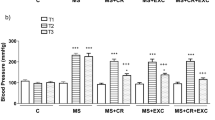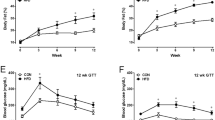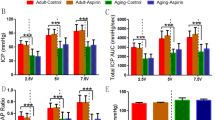Abstract
Erectile dysfunction is a common condition that affects men over age 40. It is highly related to obesity. The corpus cavernosum is the most important structure involved in erection. The aim of this study was to evaluate the structure of the corpus cavernosum of mice fed with a high energy density diet (HED). At 3 months of age, male C57BL/6 mice were fed with a HED diet (50% lipids) or standard chow (SC) diet (10% lipids) for 14 weeks. Afterwards, the animals were euthanized and the corpus cavernosum was analyzed through stereology. Statistical significance was calculated by the student’s t-test (p < 0.05). The group fed with HED diet showed higher values of body weight, blood pressure and higher rates of cholesterol, triglycerides, and glucose from the second week to the end of the experiment. The HED group showed a significant increase in the connective tissue (15%) and a decrease in smooth muscle fibers (41%). The testosterone concentration in the HED group was 63% lower than in SC animals. Animals fed with a HED presented reduced testosterone serum levels and morphological changes on the corpus cavernosum, which may be related to erectile dysfunction.
This is a preview of subscription content, access via your institution
Access options
Subscribe to this journal
Receive 8 print issues and online access
$259.00 per year
only $32.38 per issue
Buy this article
- Purchase on Springer Link
- Instant access to full article PDF
Prices may be subject to local taxes which are calculated during checkout



Similar content being viewed by others
References
Manore MM, Larson-Meyer DE, Lindsay AR, Hongu N, Houtkooper L. Dynamic energy balance: an integrated framework for discussing diet and physical activity in obesity prevention-is it more than eating less and exercising more? Nutrients. 2017; 9;905.
de Souza ILL, Barros BC, de Oliveira GA, Queiroga FR, Toscano LT, Silva AS, et al. Hypercaloric diet establishes erectile dysfunction in rat: mechanisms underlying the endothelial damage. Front Physiol. 2017;8:760.
Li R, Cui K, Liu K, Li H, Zhang Y, Liu X, et al. Metabolic syndrome in rats is associated with erectile dysfunction by impairing PI3K/Akt/eNOS activity. Sci Rep. 2017;7:13464.
Ehala-Aleksejev K, Punab M. The effect of metabolic syndrome on male reproductive health: a cross-sectional study in a group of fertile men and male partners of infertile couples. PLoS ONE. 2018;13:e0194395.
Abidu-Figueiredo M, Ribeiro IC, Chagas MA, Cardoso LE, Costa WS, Sampaio FJ. The penis in diabetes: structural analysis of connective tissue and smooth muscle alterations in a rabbit model. BJU Int. 2011;108:400–4.
Fonseca A Jr, Rodrigues CF, Martins JS, Abidu-Figueiredo M, Cardoso GP, Babinski MA. Effects of hypercholesterolemic diet by long-term on elastic system fibers penile tissue: volumetric density analysis of elastic system fibers. Int J Clin Exp Pathol. 2016;9:379–86.
Rahman NU, Phonsombat S, Bochinski D, Carrion RE, Nunes L, Lue TF. An animal model to study lower urinary tract symptoms and erectile dysfunction: the hyperlipidaemic rat. BJU Int. 2007;100:658–63.
Reeves PG, Nielsen FH, Fahey GC Jr. AIN-93 purified diets for laboratory rodents: final report of the American Institute of Nutrition ad hoc writing committee on the reformulation of the AIN-76A rodent diet. J Nutr. 1993;123:1939–51.
Montes GS. Structural biology of the fibres of the collagenous and elastic systems. Cell Biol Int. 1996;20:15–27.
Gandaglia G, Briganti A, Jackson G, Kloner RA, Montorsi F, Montorsi P, et al. A systematic review of the association between erectile dysfunction and cardiovascular disease. Eur Urol. 2014;65:968–78.
Colson MH, Cuzin B, Faix A, Grellet L, Huyghes E. Current epidemiology of erectile dysfunction, an update. Sexologies. 2018;27:e7–13.
Fraulob JC, Ogg-Diamantino R, Fernandes-Santos C, Aguila MB, Mandarim-de-Lacerda CA. A mouse model of metabolic syndrome: insulin resistance, fatty liver and non-alcoholic fatty pancreas disease (NAFPD) in C57BL/6 mice fed a high fat diet. J Clin Biochem Nutr. 2010;46:212–23.
Petro AE, Cotter J, Cooper DA, Peters JC, Surwit SJ, Surwit RS. Fat, carbohydrate, and calories in the development of diabetes and obesity in the C57BL/6J mouse. Metabolism. 2004;53:454–7.
Surwit RS, Kuhn CM, Cochrane C, McCubbin JA, Feinglos MN. Diet-induced type II diabetes in C57BL/6J mice. Diabetes. 1988;37:1163–7.
Hsu GL, Brock G, von Heyden B, Nunes L, Lue TF, Tanagho EA. The distribution of elastic fibrous elements within the human penis. Br J Urol. 1994;73:566–71.
Dean RC, Lue TF. Physiology of penile erection and pathophysiology of erectile dysfunction. Urol Clin North Am. 2005;32:379.
Akkus E, Carrier S, Baba K, Hsu GL, Padma-Nathan H, Nunes L, et al. Structural alterations in the tunica albuginea of the penis: impact of Peyronie’s disease, ageing and impotence. Br J Urol. 1997;79:47–53.
Luangkhot R, Rutchik S, Agarwal V, Puglia K, Bhargava G, Melman A. Collagen alterations in the corpus cavernosum of men with sexual dysfunction. J Urol. 1992;148:467–71.
Raviv G, Kiss R, Vanegas JP, Petein M, Danguy A, Schulman C, et al. Objective measurement of the different collagen types in the corpus cavernosum of potent and impotent men: an immunohistochemical staining with computerized-image analysis. World J Urol. 1997;15:50–5.
Yaman O, Yilmaz E, Bozlu M, Anafarta K. Alterations of intracorporeal structures in patients with erectile dysfunction. Urol Int. 2003;71:87–90.
Iacono F, Giannella R, Somma P, Manno G, Fusco F, Mirone V. Histological alterations in cavernous tissue after radical prostatectomy. J Urol. 2005;173:1673–6.
Karaboga R, Kilic O, Yaman O, Percinel S, Anafarta K. Long-term effect of experimental hypercholesterolemia on cavernosal tissues. Urology. 2006;67:431–4.
Yeşillia Ç, Yamana Ö, Anafarta K. Effect of experimental hypercholesterolemia on cavernosal structures. Urology. 2001;57:1184–8.
El-Sakka AI, Yassin AA. Amelioration of penile fibrosis: myth or reality. J Androl. 2010;31:324–35.
Traish AM, Munarriz R, O’Connell L, CHoi S, Kim SW, Huang YH, et al. Effects of medical or surgical castration on erectile function in an animal model. J Androl. 2003;24:381–7.
Shen ZJ, Zhou XL, Lu YL, Chen ZD. Effect of androgen deprivation on penile ultrastructure. Asian J Androl. 2003;5:33–6.
Morelli A, Filippi S, Mancina R, Luconi M, Vignozzi L, Marini M, et al. Androgens regulate phosphodiesterase type 5 expression and functional activity in corpora cavernosa. Endocrinology. 2004;145:2253–63.
Amidu N, Owiredu W, Gyasi-Sarpong CK, Alidu H, Antuamwine BB, Sarpong C. The inter-relational effect of metabolic syndrome and sexual dysfunction on hypogonadism in type II diabetic men. Int J Impot Res. 2017;29:120–5.
Acknowledgements
This work was supported by the agencies CNPq (Brazilian Council of Science and Technology, www.cnpq.br) and FAPERJ (Rio de Janeiro State Foundation for Scientific Research, www.faperj.br).
Author information
Authors and Affiliations
Corresponding author
Ethics declarations
Conflict of interest
The authors declare that they have no conflict of interest.
Rights and permissions
About this article
Cite this article
Alves-Pereira, J.L., Frantz, E.D.C., Pires, L.A.S. et al. Effects of a high energy density diet in the “corpus cavernosum” of mice. Int J Impot Res 31, 126–131 (2019). https://doi.org/10.1038/s41443-018-0089-4
Received:
Revised:
Accepted:
Published:
Issue Date:
DOI: https://doi.org/10.1038/s41443-018-0089-4
This article is cited by
-
Sucrose exposure during gestation lactation and postweaning periods increases the pubococcygeus muscle reflex activity in adult male rats
International Journal of Impotence Research (2022)
-
The association of popular diets and erectile function among men in the United States
International Journal of Impotence Research (2021)



